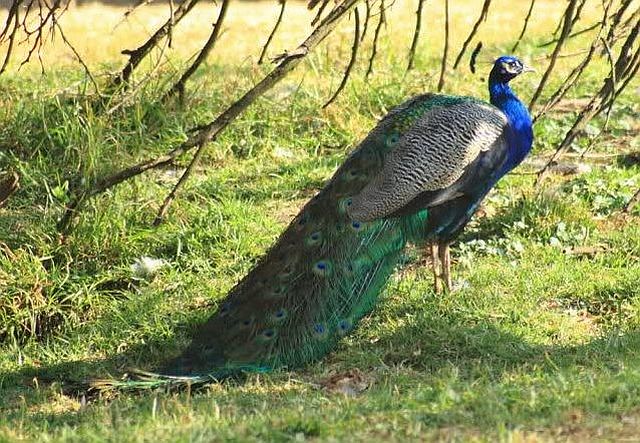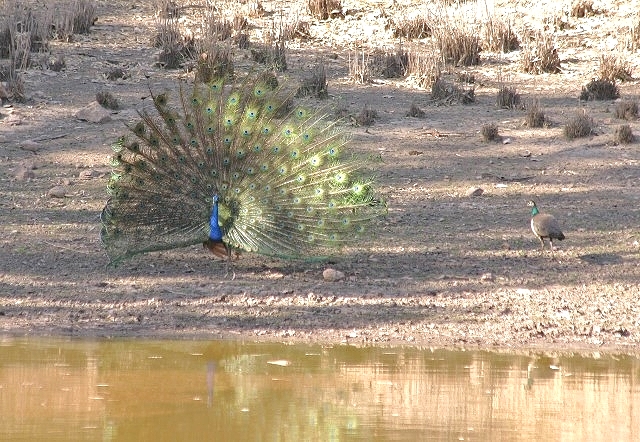Swainson's Spurfowl
Posted: Mon May 21, 2012 7:23 pm
199. Swainson's Spurfowl Pternistis swainsonii (Bosveldfisant)
Order: Galliformes. Family: Phasianidae
Description
Size 34-39 cm. Brown overall, streaked with black, bill dark above, red below; face and throat red; legs black.
Male and female have similar plumage but the male can be distinguished by having long leg spurs and the males are bigger than the females.
The juveniles have a paler less extensive red face.
Similar species: Distinguished from other spurfowl by the combination of red face, red throat, uniform brown (not black and white striped) underparts, black upper bill and black legs. The Red-billed Spurfowl might be confused with Swainson's Spurfowl but lacks any obvious unfeathered throat patches, and has red (not brown) legs and a distinctive yellow patch of skin around the eyes.
Distribution
Occurs from southern Angola and Zambia to northern Namibia, northern and eastern Botswana, Zimbabwe, western Mozambique and north-eastern South Africa.
Habitat
It generally prefers grasslands or open savannas and adapts easily to cultivated, disturbed areas.
Diet
Mainly eats plant matter in winter supplemented with insects in summer, doing most of its foraging by digging and gleaning.
Breeding
Swainson’s Spurfowl are monogamous and territorial. Nest a scrape in the ground lined with grass and leaves, hidden among vegetation. Egg-laying season is year-round, peaking from February to May. The females lay a clutch of 4 to 12 eggs in a hollow in the ground in the grassveld or bushveld that is lined with dry grass and leaves. The eggs hatch after an incubation period of about 24 days. Chicks are able to fly short distances after 10-14 days and are near adults size after 3 months.
Call
The male calls very loudly, especially at dawn and at dusk; a harsh crowing, krrraa krrraa krrraa, repeated 6-7 times and reducing in volume towards end of the series. He often calls while perched conspicuously on a fence post, tree stump or other elevated spot.
Listen to Bird Call.
Status
Very common near-endemic resident.
Order: Galliformes. Family: Phasianidae
Description
Size 34-39 cm. Brown overall, streaked with black, bill dark above, red below; face and throat red; legs black.
Male and female have similar plumage but the male can be distinguished by having long leg spurs and the males are bigger than the females.
The juveniles have a paler less extensive red face.
Similar species: Distinguished from other spurfowl by the combination of red face, red throat, uniform brown (not black and white striped) underparts, black upper bill and black legs. The Red-billed Spurfowl might be confused with Swainson's Spurfowl but lacks any obvious unfeathered throat patches, and has red (not brown) legs and a distinctive yellow patch of skin around the eyes.
Distribution
Occurs from southern Angola and Zambia to northern Namibia, northern and eastern Botswana, Zimbabwe, western Mozambique and north-eastern South Africa.
Habitat
It generally prefers grasslands or open savannas and adapts easily to cultivated, disturbed areas.
Diet
Mainly eats plant matter in winter supplemented with insects in summer, doing most of its foraging by digging and gleaning.
Breeding
Swainson’s Spurfowl are monogamous and territorial. Nest a scrape in the ground lined with grass and leaves, hidden among vegetation. Egg-laying season is year-round, peaking from February to May. The females lay a clutch of 4 to 12 eggs in a hollow in the ground in the grassveld or bushveld that is lined with dry grass and leaves. The eggs hatch after an incubation period of about 24 days. Chicks are able to fly short distances after 10-14 days and are near adults size after 3 months.
Call
The male calls very loudly, especially at dawn and at dusk; a harsh crowing, krrraa krrraa krrraa, repeated 6-7 times and reducing in volume towards end of the series. He often calls while perched conspicuously on a fence post, tree stump or other elevated spot.
Listen to Bird Call.
Status
Very common near-endemic resident.
 © Toko
© Toko © harrys
© harrys © lowveldboy
© lowveldboy © Pumbaa
© Pumbaa © Sprocky
© Sprocky

 © Flutterby
© Flutterby © nan
© nan © nan
© nan © Amoli
© Amoli